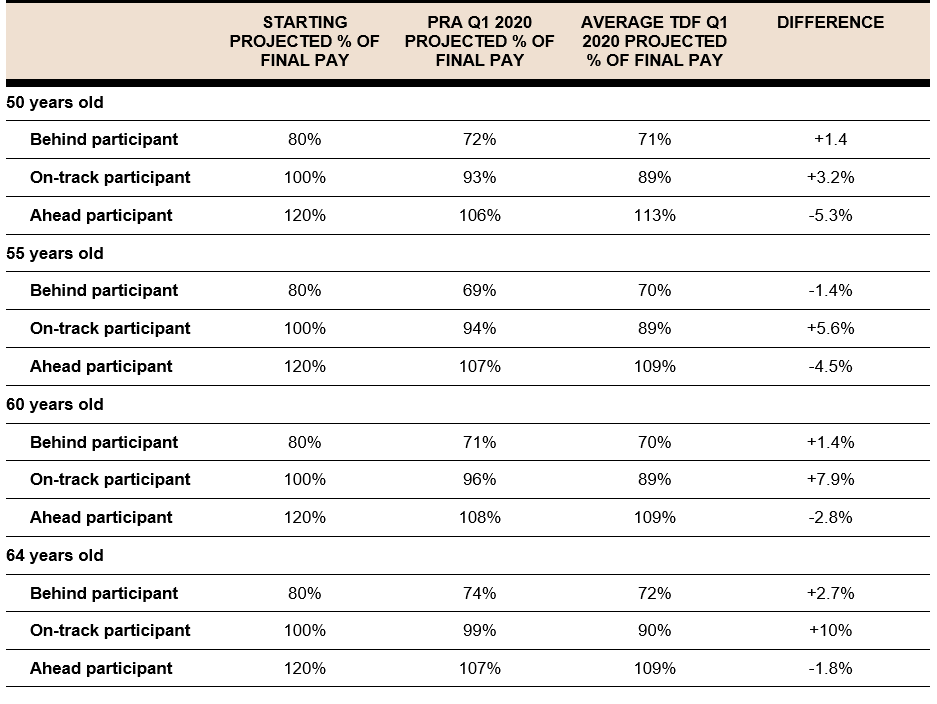by Kevin Knowles, Russell Investments
When it comes to retirement, timing shouldn’t have to be everything.
Unfortunately, when markets unravel, as they did this past March, it’s often those on the cusp of retirement who suffer the most. Relatively high allocations to more volatile asset classes, coupled with little time to rebound, can lead to retirees being forced to live with less income for the duration of their retirement—or delaying retirement altogether. While target date funds are designed with a level of de-risking over time, this simplicity is often put to the test during trying times, as relatively high equity allocations erode balances.
It doesn’t have to be this way. We believe that the personalized approach used with managed accounts can help solve for this common problem, preventing diligent savers from being blindsided by market chaos. Simply put, managed accounts consider individual circumstances first and foremost, meaning that the market experience is effectively tailored for each person's unique situation. This allows diligent savers, for example, to realize the savings efforts they made throughout their careers with a smoother path to sufficient retirement income—even when markets are down.
The limitations of target date funds
Target date funds are the dominant savings vehicle for retirement investors, particularly within employer-sponsored defined contribution plans, gathering $1.8 trillion in assets as of the middle of 2019.¹ During less volatile times, investors tend to look at trailing performance and feel regret if their funds’ performance lags other available solutions in the marketplace. The pressure to stay competitive has led some target date providers to increase their equity exposure, particularly for investors approaching retirement.
It isn't until stressed times that these solutions are brought under the microscope, and the importance of diversification and appropriate risk levels are surfaced as investors start to see significant drops in their balances. As proof, just look at some media headlines throughout different time periods of market volatility.
- Target-date funds missed the target in 2008 (Marketwatch, February 4, 2009)
- Target funds miss the mark (Fortune Magazine, April 27, 2009)
- Market plunge tests performance of target-date funds (Investment News, March 6, 2020)
- Target-date funds are failing those on the cusp of retirement (Marketwatch, April 14, 2020)
¹ https://www.plansponsor.com/research/2019-target-date-fund-buyers-guide/2/. Data as of June 30, 2019, report as of September 18, 2019.
However, a few years after a downturn, people tend to forget the importance of diversification and the pain of losses. In these articles, the media trashes the very same funds that they and the rating firms had been praising. In fact, three of the five worst performing 2020 target date funds during the first quarter of 2020 had their series rated silver in the Morningstar 2019 Target Date Fund Landscape Report.²
² The Morningstar Analyst Rating for funds is the summary expression of the forward-looking analysis of a fund. Morningstar Analyst Ratings are assigned globally on a five-tier scale running from Gold to Negative. The top three ratings, Gold, Silver and Bronze, all indicate that the analysts think highly of a fund; the difference between them corresponds to differences in the level of analyst conviction in a fund’s ability to outperform its benchmark and peers through time, within the context of the level of risk taken.
How did target date funds fare during the recent selloff?
During the first quarter of 2020, target date funds designed for participants in their final year of work (i.e., 2020 funds) had returns that ranged from -14.2% to -2.7%. Those five years from retirement (i.e., 2025 funds) returned from -3.92% to -16.32%.³ To put that in perspective, participants in their final year of work could have taken a 14% salary cut for the rest of their lives.
It's true that for some participants, particularly those who had saved less than adequate levels over their careers, they needed to take those risks. Their 14% drop in income is also less relevant because they were behind on their retirement savings objectives and will likely need to continue working, perhaps participating in a future positive market scenario.
But for participants who have been diligently saving throughout their working years with the objective of retiring at the end of 2020, these results are devastating. The savings behaviors of their coworkers may have forced their employers to select more aggressive target date series and the fruits of their savings labor were not realized.
And therein lies the number one issue of target date funds—employers are forced to solve a problem for one cohort of their participant base at the detriment of another.
The issue cuts both ways. Employers who are looking to protect diligent savers sacrifice low savers by not providing enough growth to overcome insufficient savings. Those looking to help low savers are negatively affecting diligent savers by providing an allocation that is too aggressive to withstand during down-market periods. It is a true conundrum for advisors, consultants and plan sponsors.
³ Source: Morningstar
What participant base are you trying to solve for?
Solving for these participants...Punishes these participants..."Behind" participants by giving them higher equity allocations."On track" participants that suffer from aggressive allocations during a downturn near their retirement dates."On track" participants by helping to protect them with lower equity allocations."Behind" participants by not providing enough equity exposures to overcome insufficient savings.
If given the opportunity, most plan sponsors would likely agree that it would be better for their entire participant base if they could put the diligent savers in the target date fund that just lost 2.7% but perhaps gave up potential upside over the years. Plan sponsors could then put the low savers in the fund that just lost 14% but participated in the most recent bull market. Even better would be to put the low savers in the high-risk funds and then move them to the low-risk funds if the market movements can help put them in a better situation.
If this type of solution sounds attractive, it is exactly what managed—or personalized—accounts—seek to do. These accounts automatically pull data for each participant and apply a personalized allocation to their portfolios based on their situation. Low savers receive a higher risk allocation (within reason) and diligent savers receive a smoother (i.e., less aggressive) path to retirement. Allocations are adjusted periodically as the markets and participant's situations change.
Let's look at the most recent market period (i.e., the one ending March 31, 2020). As discussed previously, we know that some target date funds delivered undesirable results for participants at or near retirement—the critical years approaching retirement—but we were looking at it through the wrong lens. Instead, let's look at performance as the ability for participants to replace their paycheck in retirement. After all, that is the goal of a defined contribution (DC) plan.
The difference between performance and the projected ability to replace a paycheck is the impact of future savings. Note that participants who just entered the workforce are not impacted by a downturn, because they don't have any money to lose and their future savings will immediately make up for the loss. Those in the final year don't have a chance to make up for the loss with savings, because they are at the end of their savings career. People in the middle fall in-between. In Exhibit 1, we explore some specific examples focused on some sample of those aged 50 to 65 years.
Source: Russell Investments, see Appendix for further information
The comparison above demonstrates the expected income replacement difference from a managed account versus the industry's average target date funds for participants who are at different ages and in different situations. We ran this analysis through thousands of scenarios and have organized the expected outcomes of four sample age cohorts—50-year-olds, 55-year-olds, 60-year-olds and 64-year-olds—according to the sample participants' situations: behind, on-track or ahead of their goals. We compared their projected income based on an assumed balance at the beginning of 2020 to their projected income based on an assumed balance after the hypothetical impact of first-quarter returns. We summarized the results in Exhibit 1, focusing on the market scenario where 70% of scenarios were better (i.e., 30th percentile).
- Behind participants: As previously stated, managed accounts often provide more allocation to growth or risky assets for those whose behind-track status is a common condition for DC savers. This allocation policy provides higher projected retirement income levels for this group than an alternative investment in target date funds in three of the four age cohorts. The results for the 64-year-old who is in the final year of work and has little time to recover had noteworthy results of +2.7% versus the average return in target date funds.
- On-track participants: For participants who are on track, the conservative allocation produced the intended outcomes. In all cohorts, these participants experienced lower volatility in their projected retirement income level. Again, of note is the 10% more in projected income for the 64-year-old.
- Ahead participants: Managed accounts often provide a higher allocation to growth assets for these participants. Ahead participants have the capacity to bear additional risk, as they have reached their primary goal of meeting an appropriate retirement income level and can pursue a secondary objective of increasing wealth. Given the recent drawdown in the market, participants in this cohort had relatively lower income projected in retirement, but their primary goal of meeting their income objectives remained intact. These participants would likely be re-evaluated into a more conservative allocation by their managed accounts partner that would prevent them from falling behind.
Conclusion
Negative market environments highlight the importance of personalized solutions. Plan sponsors should explore if an individually customized approach is more appropriate than a simple age-based solution. Doing so gives plan sponsors and advisors the ability to move the focus away from distracting short-term market returns and toward outcomes for their participant base. We believe the most important decision for plan sponsors is not to select the best-performing solution for their plan, but rather one that aligns with their philosophy and objectives while simultaneously solving for the wide breadth of participant circumstances⁴.
Appendix
Additional information for Exhibit 1:
30 percentile result is displayed.
The table is showing a projected income replacement rate of different hypothetical participants. The distinguishing factor between the three hypothetical participants is their account balance at each age. The “Behind” participant has a low account balance, the “On-track” participant has a moderate account balance and the “Ahead” participant has a high account balance. All other attributes of the hypothetical individuals are identical. The goal for these hypothetical participants is 100%, therefore a result of 100% means the participants are meeting their retirement income goals exactly. In this analysis, we ran approximately 2,000 market scenarios using Russell Investments capital market assumptions as of 12/31/2019 and included the following asset classes: U.S. Large Cap Equity, U.S. Small Cap Equity, Non-U.S. Developed Equity, Global Equity, Emerging Markets Equity, Global REITs, Commodities, Listed Infrastructure, High Yield Bonds, U.S. Aggregate Bonds, U.S. TIPS and U.S. Short-Term Bonds. The final account balances were translated into an annual spending amount based on our proprietary annuity pricing model. In this table we are showing the results for the 30th percentile. The PRA column shows the hypothetical projected results if the hypothetical participants are invested using the PRA methodology. The average target date fund uses the average target date glide path based on most recent public filings of all target date mutual fund series as of 12/31/2019. The returns for the first quarter of 2020 based on the allocation between stocks (MSCI ACWI Index) and bonds (Bloomberg Aggregate Index) based on PRAs Methodology. The first quarter 2020 returns are the actual average category returns for target date funds according to Morningstar Direct.
Assumptions for Exhibit 1:
- Balance at age 50 -- Behind participant: $240,000; on-track participant: $380,000; ahead participant: $550,000
- Balance at age 55 -- Behind participant: $360,000; on-track participant: $520,000; ahead participant: $700,000
- Balance at age 60 -- Behind participant: $510,000; on-track participant: $680,000; ahead participant: $860,000
- Balance at age 55 -- Behind participant: $660,000; on-track participant: $830,000; ahead participant: $1,010,000
- Salary -- $100,000 at age 50; $98,000 at age 55; $94,000 at age 60; $90,000 at age 64 decreasing per year until age 65 at which point it reaches $90,000
- Savings rate – 13.9% at age 50; 14.7% at age 55; 15.4% at age 60; 16.0% at age 64
- Gender -- Male
⁴ See "Evaluating managed account performance: Understanding the differences."
Copyright © Russell Investments















